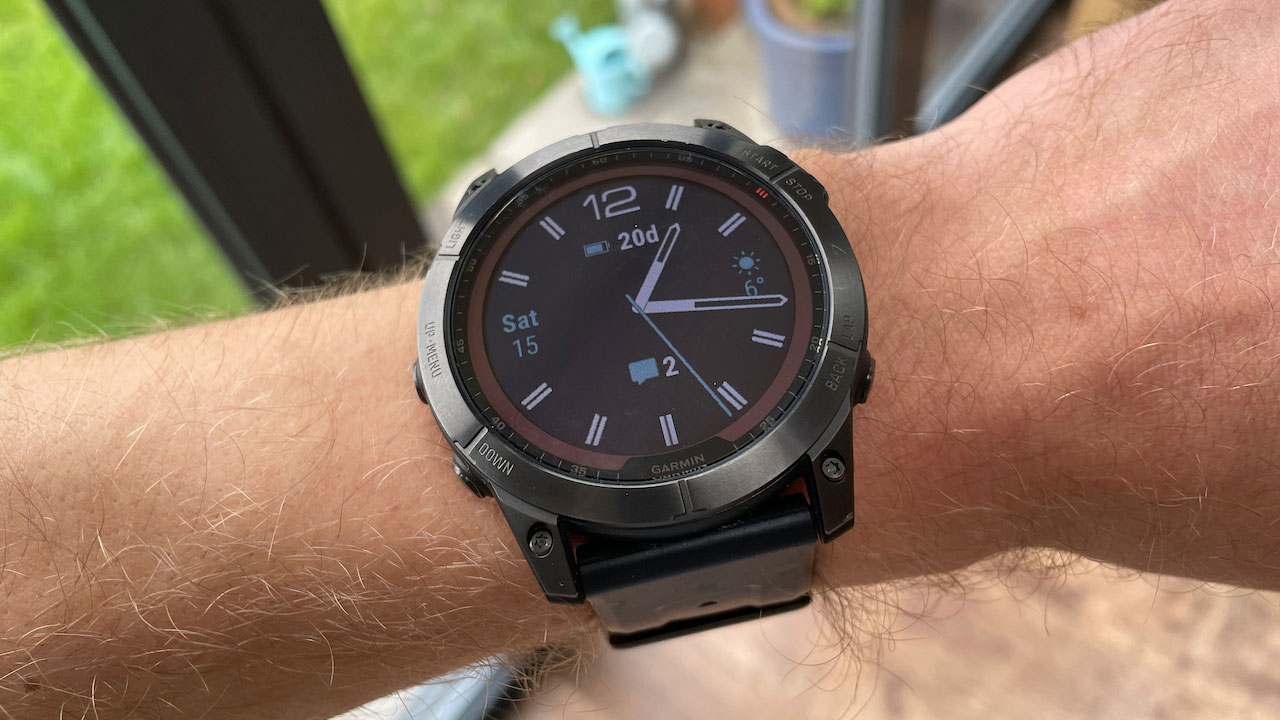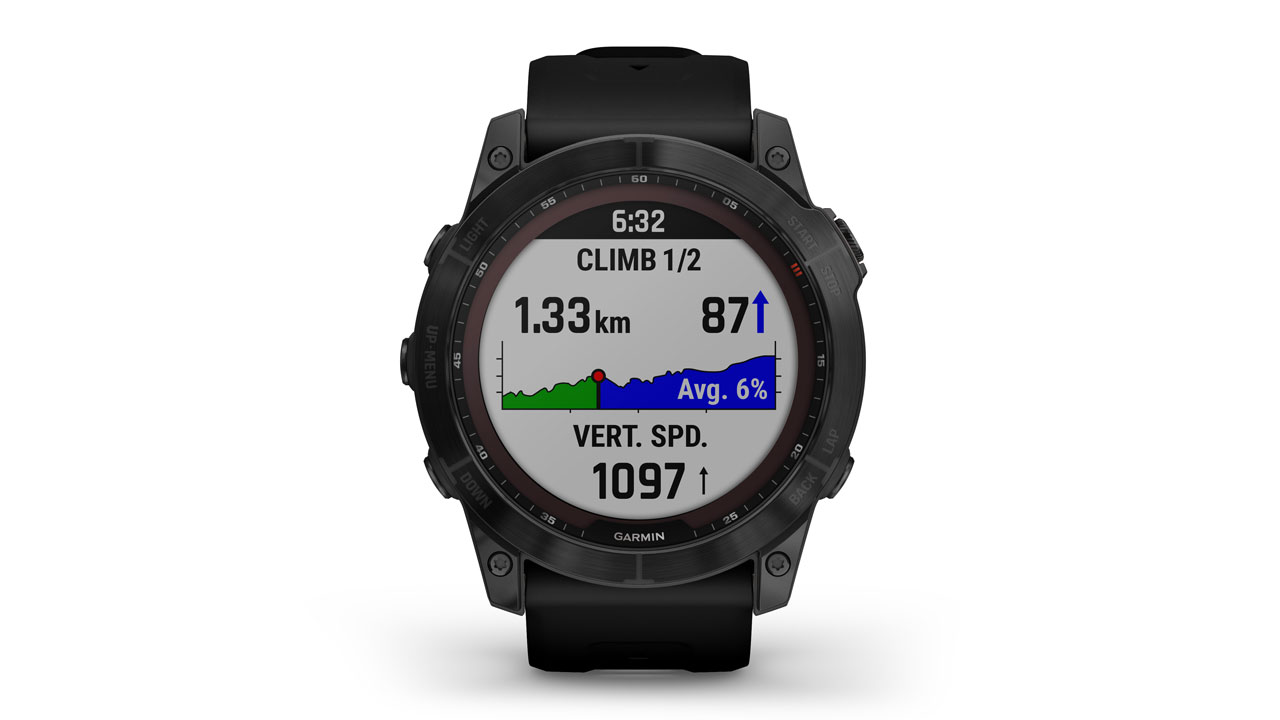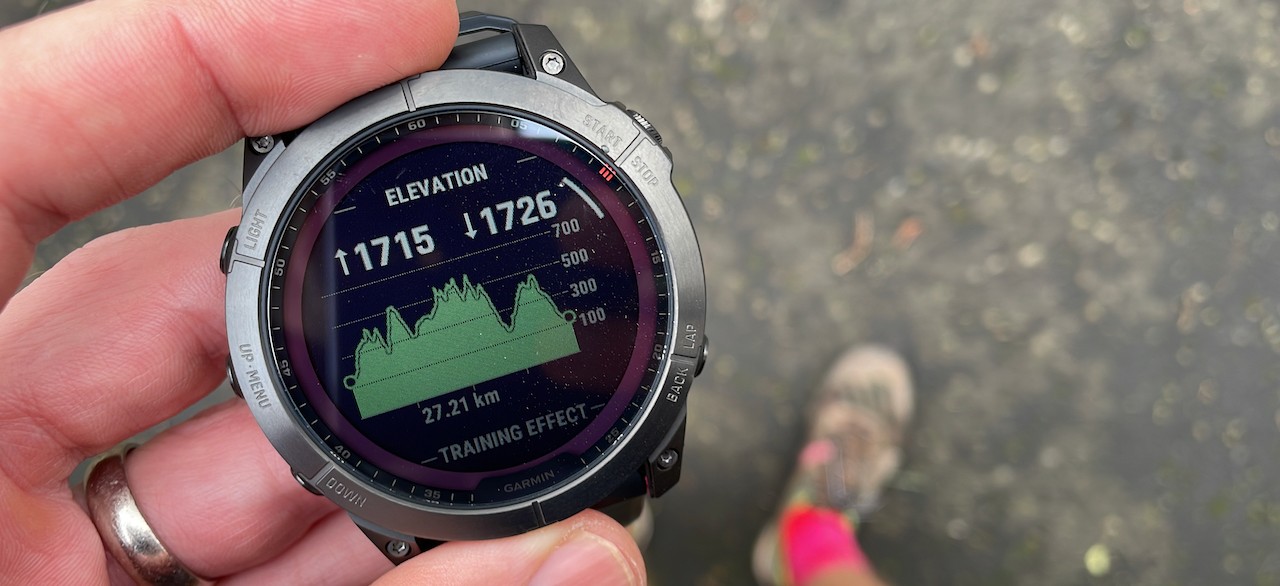Our Verdict
Garmin’s latest generation of the Fenix line has made some small but welcome improvements, better GPS accuracy and longer battery life chief among them. In this price range, the only real rival to the Fenix 7’s supremacy is Garmin’s own Epix 2 watch.
For
- Top-notch sports tracking
- Long battery life
- Improved GPS accuracy
- Touchscreen
- Colour maps and clever navigation tools
Against
- Very expensive
- The 7X in particular is a hefty watch
You can trust Coach
The Garmin Fenix 6 Pro has been the best sports watch since it launched, with the only possible pretender to its crown in the £500-plus bracket being the lighter Garmin Forerunner 945. With the launch of the Fenix 7 range, Garmin has tightened its grip on the top spot, improving the battery life and the accuracy of the GPS, while debuting some interesting features and a touchscreen.
I’ve spent several weeks testing the Fenix 7X and Garmin’s other new device the Epix 2, which is essentially a Fenix 7 with an AMOLED screen, and can say that if you’re shopping in this money-no-object bracket and want the very best, then your choice is simple: either opt for the longer battery life of the Fenix, or the brighter screen of the Epix 2.
- NEWSFLASH: The Garmin Enduro 2 is Garmin’s new top sports watch
Garmin Fenix 7X: Release Date And Price
The Garmin Fenix 7 range launched on 18th January 2022 and the watches cost from $699.99/£599.99 up to $999.99/£1,049.99, depending on the model and materials you opt for. The cheapest watches available are the steel Fenix 7S and Fenix 7, while the most expensive is the Fenix 7X Sapphire Solar, which has a titanium bezel, a sapphire crystal screen and solar panels around the face to increase battery life.
Recent updates
December 1, 2023: There are now regular sales and deals featuring the Garmin Fenix 7. In our extensive coverage of the best Black Friday Garmin deals in 2023 the best prices we tracked were $449.99 and £449.99. Our deal tracking of Amazon Prime Day Garmin deals in 2023 revealed a best price of £419.99.
Design And Hardware Specs

The Fenix 7 range offers the same three sizes as the Fenix 6 range, with the standard 7 (47mm) flanked by the smaller 7S (42mm) and larger 7X (51mm), pictured. The screen sizes are 1.2in (30mm) on the 7S, 1.3in (33mm) on the 7, and 1.4in (35.5mm) on the 7X. The battery life also increases with size.
All the watches in the Fenix 7 range have touchscreens, though you can still navigate the watch using just the five buttons. However, the touchscreen is responsive and I quickly started to use it to scroll through my widgets and dismiss notifications, rather than use the buttons.
The Fenix 7X model I tested was the sapphire solar edition, which has a titanium bezel. Aside from improved materials, there are some features that are reserved for more expensive Fenix models. Most notably, multi-band support for better GPS accuracy is not included on non-sapphire editions of the watch. All watches get multi-GNSS tracking (using GPS, Galileo and GLONASS satellite systems simultaneously) which will result in improved accuracy compared with the Fenix 6 range. Another difference is that the sapphire watches come with global TopoActive maps preloaded, while you have to download the maps yourself (free) with the cheaper models.
Another upgrade with the solar editions of the Fenix 7 is increased battery life in sunny conditions thanks to the solar panels on the watch face. One final feature that is reserved for the Fenix 7X watch is a built-in LED flashlight.

You can get a bit lost splitting hairs between the 22 models in the range, but after testing the 7X I would say the upshot is that you can opt for the cheapest models and still enjoy the best features of the Fenix 7. Those who do upgrade will benefit mostly from lighter materials and the solar charging: the GPS accuracy of the watch is not significantly improved by the multi-band mode available on sapphire editions.
All the Fenix 7 watches are waterproof to 10ATM, have a heart rate sensor, and come with multi-GNSS tracking that uses GPS, Galileo and GLONASS satellites at the same time. There’s also an altimeter, barometer and compass, as well as a pulse oximeter to track blood oxygen saturation, and the ability to connect external sensors via both Bluetooth and ANT+.
GPS Accuracy
While I have enjoyed using the Fenix 6 Pro for much of the past couple of years, the GPS tracking had flaky moments – but the Fenix 7 delivers a substantial improvement in performance. That improvement is primarily down to the multi-GNSS mode available on all the Fenix 7 watches. The multi-band mode perhaps increases the accuracy even further, although not notably so in my testing.
There are still times when the GPS tracking will let you down, but these are now few and far between, and if using the Fenix 7 for tracking your lap or current pace, you should see more consistency.
Battery Life
Battery life sees a sizeable jump across the Fenix 7 range compared with the 6. Even the smallest 7S watch now offers 37 hours of GPS tracking, up from 25 on the 6S, while the 7’s battery rises from 36 hours of GPS to 57. Those numbers can be increased by the solar panels if you have a solar edition, but note they are based on tracking using GPS only, so will also come down if you use the multi-GNSS or multi-band modes.
The 7X I’ve been testing has been superb on the battery front even if you whack it into the most battery-intensive GPS setting at all times. It lasted me three weeks when I ran almost every day and tracked almost every activity in the multi-band GPS mode. On a three-hour run in sub-zero conditions (cold weather usually causes battery life to decrease more) the 7X dropped just 5% in the multi-band mode.
If you use the multi-GNSS setting you’ll see the Fenix 7X last more than a month comfortably, and you can even extend how long a charge lasts you by using Garmin’s power manager feature and, for example, setting up reduced power modes that kick in at night. I never bothered with this – even using the Fenix 7X as hard as I could, it lasted three weeks, and this was in the dull depths of the British winter when the solar panels did very little for me.
New Features
The best new stuff on the Fenix 7 range is hardware-related, but there are some interesting new software additions too. The most intriguing of these is the stamina feature, which will analyse your recent training to give an indication of how much juice you have left during your activities.

This is an ambitious aim and I find it very hard to believe I could ever trust a watch’s rating of my remaining stamina over my own assessment. During my tests of this feature, which included a cross-country race, it left me fairly confused. My stamina rating on the watch didn’t always fall and rise in line with how I felt the run was going.
However, it’s one of those features where a combination of the watch learning more about the user and the user becoming more familiar with the feature may improve the experience, and it could well end up being a useful way to help you pace longer events and stop you going out too fast. That said, I struggle to see it replacing pace, heart rate and Garmin’s nifty PacePro feature as methods to judge my race efforts.
Smaller updates to the Fenix 7 include a HIIT workout mode, and upgraded race predictions with graphs showing your estimated times for 5K, 10K, half marathon and marathon events and how they have changed over time. The Fenix 7X also gets a built-in LED torch which is surprisingly bright and useful. It was handy when negotiating a dark house to reach a complaining child at night, but it would also be a welcome extra light when camping, especially since it also has a red-light mode.
Sports Tracking

Like its predecessor, the Fenix 7X is an incredibly comprehensive sports tracker. It offers all the stats you could want for every type of activity I can think of and backs that up with insightful training analysis. The analysis can help you judge your recovery and balance your training load, so you’re getting the right mix of easy and hard training. The watch can also suggest workouts each day, and tell you how well you are acclimating to heat and altitude.
To get the most from the Fenix 7X I recommend pairing it with a chest strap heart rate monitor to track your activities, because the optical heart rate tracking suffers from the usual problems you get with such tech. On some runs it was wrong throughout, and often lagged behind a chest strap’s readings during interval sessions when my heart rate spiked and dropped quickly. The heart rate information gathered from workouts feeds into all of Garmin’s most useful training load analysis, so it’s really worth making sure you’re getting the most accurate data if you’re planning on using that analysis to guide your training.
Overall, there is no more advanced watch for sports tracking than those in the Fenix 7 range, and the new devices benefit from improved battery life and GPS tracking too.
Maps And Navigation

Garmin’s on-wrist maps and navigation features on its flagship devices are the best in the business, and that remains the case with the 7X.
The maps are clear, and turn-by-turn directions make routes easy to follow when running or cycling. You can also create new routes on the watch itself if you’re just looking for a loop to do when in a new place, or you’re lost and trying to get back to your starting point.
One of my favourite features on any watch is Garmin’s ClimbPro, which identifies all the climbs in your route and shows stats on each. It can help you judge your effort on an individual climb since you can clearly see how much more elevation you have to conquer, and help you pace longer runs with multiple ascents to consider. On a long run in the Scottish Pentlands with 1,700m-plus of uphill work, it was very helpful to know just how hard and long each climb was going to be when I started it, especially in misty weather when I couldn’t see the top.

Although Coros now offers maps on its Vertix 2 watch and you can get maps on some smartwatches, Garmin’s are easier to use and more feature-rich. The only note I have is that I preferred using the maps on the new Epix 2 watch to the Fenix 7X, because the vibrant AMOLED screen made them clearer.
Smart Features
While the Epix 2 smartwatch has an AMOLED screen, which makes it look the part more than the transflective displays on the Fenix 7 range, you do get all of Garmin’s smartwatch features on the 7X.
These are a mixed bag. The music integration is excellent if you’re a Spotify Premium user, with offline playlist support, and the ability to wirelessly transfer playlists and podcasts. You can also manually transfer files to the watch. I also like the weather widget on the watch, which gives enough detail to help you plan out activities.
Garmin Pay is less impressive, at least in the UK, because Santander remains the only high street bank supported, though you can also use Starling and Revolut cards with the feature.
It’s the selection of apps where Garmin really lags behind the best smartwatches, though –the Connect IQ store mostly contains watch faces and extra data fields for sports modes. Some of these are useful, and there are some handy general apps like Spotify, but it’s a far cry from what you get on the Apple or Android app stores.
Activity And Sleep Tracking
While primarily sports watches, the Fenix 7 range will track all of your daily activity, including steps, calories burned and active minutes, and the steps target can be set to automatically adjust in line with how active you are so the goal is always suitable.
Garmin’s Body Battery feature is also a useful one-stop shop for checking in on your energy levels. You get a rating out of 100 that’s based on things like your heart rate variability, recent activity and sleep.
However, the sleep tracking on the Fenix 7X has shown the same flaws I’ve experienced with all Garmins, in that it often overestimates my time asleep. When sitting on the sofa watching TV or lying in bed reading, the device thinks I’m asleep, resulting in artificially high sleep ratings. For example, just this morning my toddler insisted on coming into our bed at 5.30am and kept me awake from then on until we got out of bed just after 7am, but my Garmin sleep record showed me in light sleep for much of that time.
Is It Worth It?
The Fenix 7 range features significant improvements over the Fenix 6. Better GPS accuracy and longer battery life are developments that will benefit every user. How much those improvements are worth to you is worth considering, though, because the Fenix 6 range still has the bulk of the features of the 7 and is now likely to be available for substantially less than £600 in sales – the Fenix 6 Pro dropped below £400 last Black Friday, for example.

Also worth considering is the Garmin Epix 2, which adds an impressive AMOLED screen to the 7X’s feature set. When testing the Fenix 7X and Epix 2 side by side, the screen did really stand out as a serious improvement on the Fenix’s transflective display, being brighter in all conditions. The battery life of the Epix 2 does drop substantially as a result – I got through around five to seven days with heavy use and the screen set to always-on – but that might be a trade-off you’re willing to make. If you are, you will have to pay more: the Epix 2 starts at £799.99.
Within the Fenix 7 range you can opt for the cheaper models and still get a great experience. The titanium watches are lighter and there’s more battery life to be enjoyed with the solar editions, plus the multi-band GPS, but the tracking accuracy and battery life is still excellent across the range.
Naturally you also have to ask yourself whether any of these watches are worth the considerable outlay involved – especially when there are fantastic sports watches like the Coros Pace 2 and Garmin Forerunner 245 available for under £300. If you want all the best features available in one watch then it’s the Fenix 7 or Epix 2, but in truth it’s probably more watch than the vast majority of us really need.
Assuming you are happy splashing the cash, though, then it is the Fenix or Epix 2 you should splash it on. The closest contender from other brands is the Coros Vertix 2, which costs £599.99 and offers even more battery life, but the maps and music features on the Vertix 2 fall well short of those available on the Garmins.
- Garmin Fenix 7 Vs Garmin Epix 2: Garmin’s Top Sport Watches Compared
- Garmin Fenix 7 Vs Garmin Fenix 6: Is It Worth Upgrading To Garmin’s New Watch?
More About Garmin And Sports Watches
- How To Buy The Best Garmin Fitness Tracker For You
- These Garmin Sales Will Help You Get A Cheap Running Watch Or Smartwatch
- The Best Running Watches
- The Best Fitness Trackers

Nick Harris-Fry is a journalist who has been covering health and fitness since 2015. Nick is an avid runner, covering 70-110km a week, which gives him ample opportunity to test a wide range of running shoes and running gear. He is also the chief tester for fitness trackers and running watches, treadmills and exercise bikes, and workout headphones.


